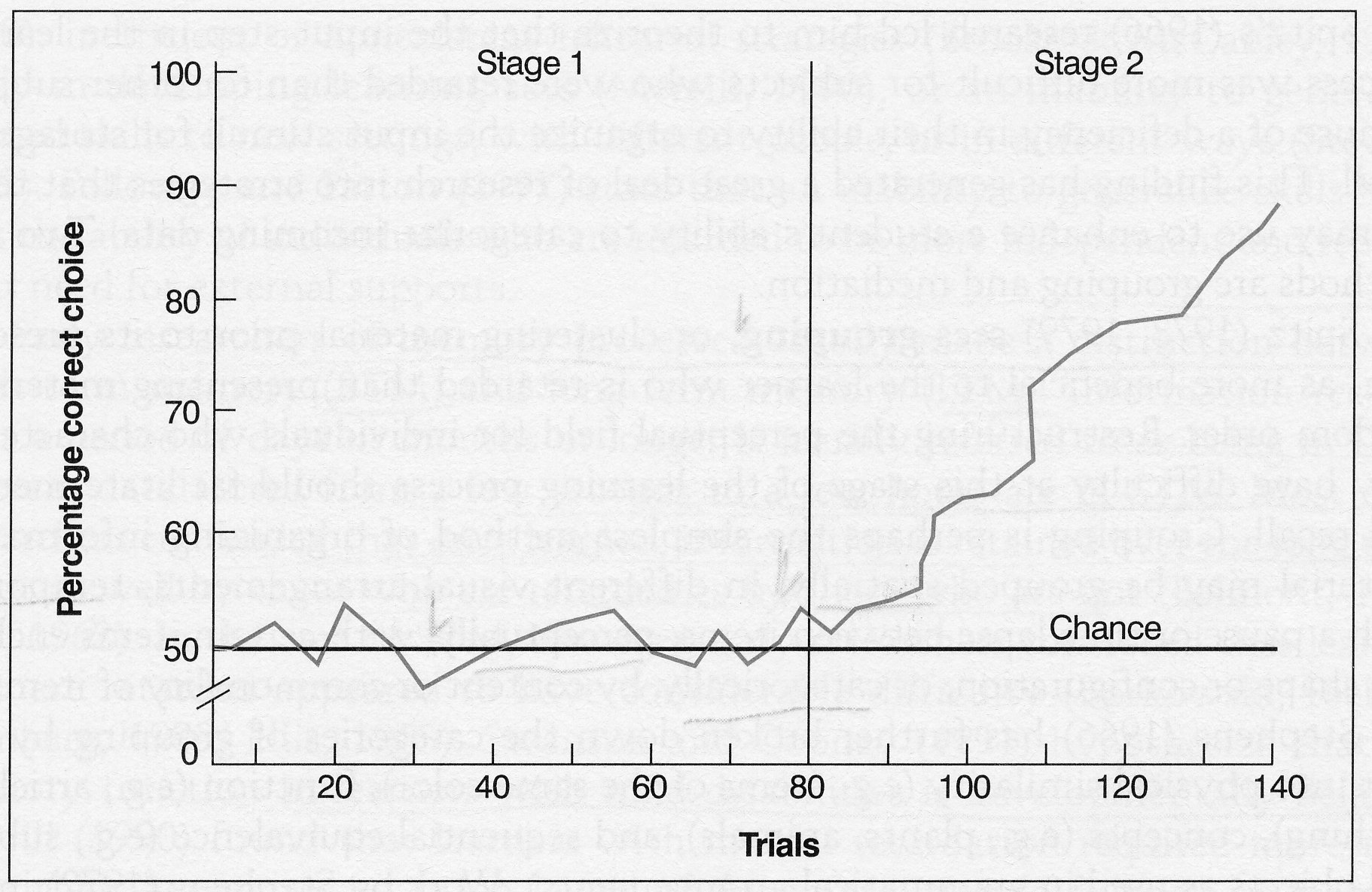
Learning
may be thought of as a process that occurs when an individual has experiences
that change their behavior. This is different than changes that occur due to
maturation and growth. We can measure learning by documenting change in students'
performance and we must have data systems in place to document these changes.
Many factors affect learning and we should be cautious about making assumptions
of learning based on students' current performance. Individuals with cognitive
impairments experience delayed development and the degree of their delays correlate
with the individual's level of cognitive disability as well as other conditions.
Quantitative versus Qualitative Differences
Historically, individuals with cognitive disabilities were often compared
to peers based on mental age (MA). Mental age refers to level of cognitive
development
while "chronological age" relates to the student's age in years. Some
persons have considered student needs based on individuals MA while ignoring
their chronological age. This typically leads to educational programming that
is "age inappropriate". An example of an age inappropriate skill focus
might be having an 18-year-old working on stacking blocks. Stacking blocks is
not an age-appropriate skill. Rather than stacking blocks, we could have the
individual removing dishes from the dishwasher and stacking them in the cupboard.
In both scenarios, stacking is being addressed but with the second example the
skill is worked on in a functional and age-appropriate manner. The developmental
perspective assumes that students with cognitive disabilities move through the
same developmental sequences as children without disabilities but they move through
sequences at a slower rate and thus reach a lower level of ultimate functioning.
Another perspective, the "difference position" suggests that the
cognitive development of these learners is qualitatively different from peers
without disabilities.
Research has identified differences in the way individuals with disabilities
process information. It is important for educators to account for these differences
in planning for instruction for learners with cognitive disabilities.
Attentional Variables
Attention to the task is essential to learning. Zeaman & House (1963) studied
attentional variables with learners and have documented their findings in learning
curves. These researchers found that learning discrimination tasks occurred in
two stages. Initially, the learners responded correctly about 50% of the time
(about chance level). During the second stage, however, the number of correct
responses increased dramatically. These researchers concluded that the first
stage is an attentional stage where the learner randomly attends to variables
within the task. Once learners identify the key features (the relevant stimuli)
the learning curve rapidly increases. In comparing learners with and without
cognitive disabilities, they found the two stages in both groups. Learners with
cognitive disabilities however, required a greater number of trials before moving
onto the second stage. The figure below provides graphic representation of the
two stages of learning identified by Zeaman & House.

Zeaman and House conducted further study of the relationship between mental age and attention to relevant variables. They found that learners with cognitive disabilities could not attend to as many dimensions of stimuli at one time.
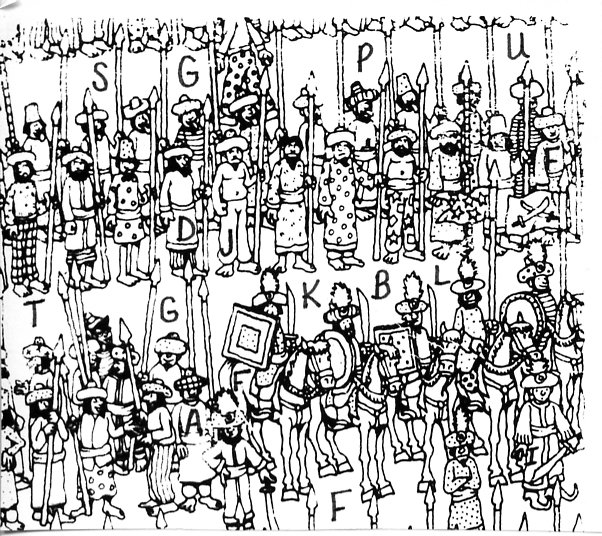
Look at the picture of "Where's Waldo". Do you see the letters S,
G, P, U, B, L, F, & T? You can see that if we are trying to teach a student
these letters, we would not want to present them with many distracting stimuli.
Now look for the D, J, F, A, I. These are even more difficult to attend to
because the stimuli have increased. While this may seem like an extreme example,
for many learners with cognitive disabilities, even minimal extraneous may
make it difficult for them to attend to the relevant dimensions of the stimuli
we are presenting, thus making it more difficult for them to learn.
Let's consider teaching a young child to differentiate between the colors blue and green. If we presented these colors to the learner by using the pictures below (blue frog and green turtle), we would be presenting stimuli with extraneous stimuli (e.g., the shape of the two stimuli, the position of the stimuli). It will take longer for the learner to attend to the relevant dimension (color) because the stimuli vary along several dimensions.
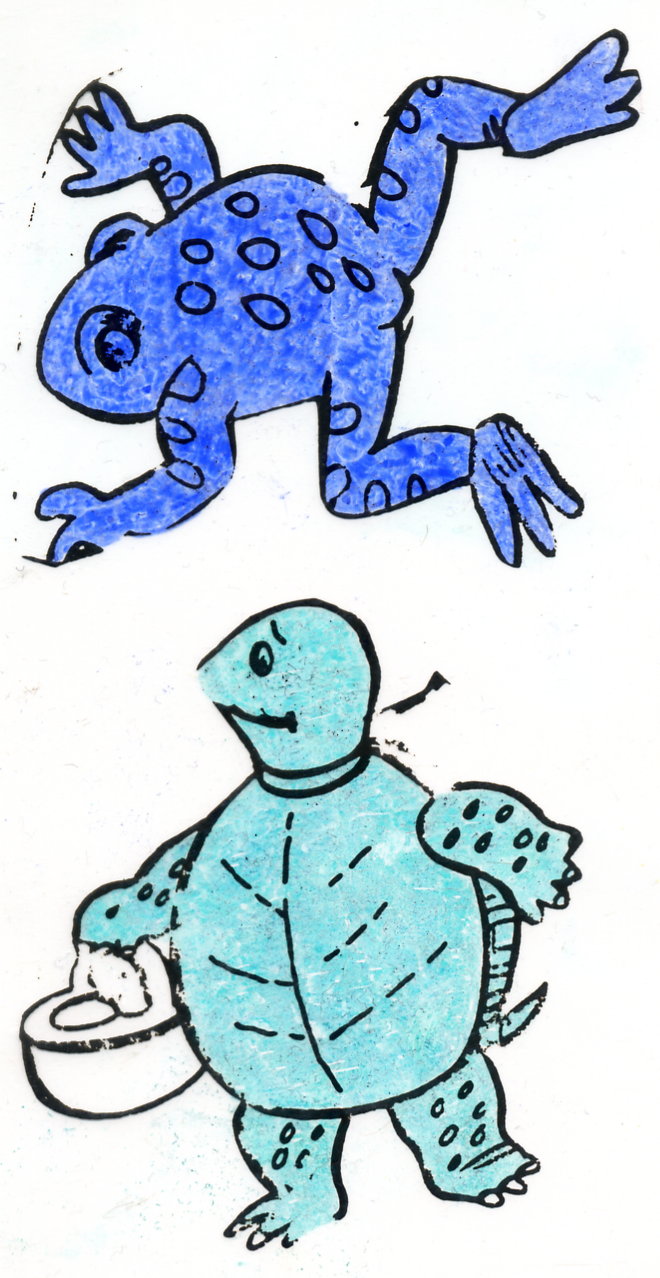
If, however, we presented the following stimuli (a green bird and a blue bird) in teaching the colors blue and green, the stimuli vary only on one dimension (color) therefore allowing the learner to attend more easily to the relevant stimulus.

Implications for Teaching:
1. present stimuli that vary in only a few dimensions
2. direct the learner's attention to the relevant variables
3. remove extraneous stimuli that might affect the learner's attention
4. reinforce the learner for attending
5. increase task difficulty over time
Mediational Strategies
Once a learner attends to the relevant stimuli in a learning task, they must
organize it in a way that they can store it in memory and recall it later when
needed. Spitz (1966) refers to this as "input organization". The
research conducted by Spitz indicated that learners with cognitive disabilities
had more difficulties in organizing information for storage and recall. Researchers
have studied "input organization" in learners with cognitive disabilities
to identify strategies that facilitate this for learners. Two strategies for
organizing input are grouping and mediation.
GROUPING-clustering material prior to presentation to facilitate organization.
There are various ways to group material. These are discussed below with
examples.
Spatial Grouping-grouping stimuli in different visual arrangements. In the
following example, all the letters presented have similar qualities (they
loop above or below the line). By presenting this stimuli in the visual
arrangements, the stimuli are separated from one another, making differentiation
less difficult.
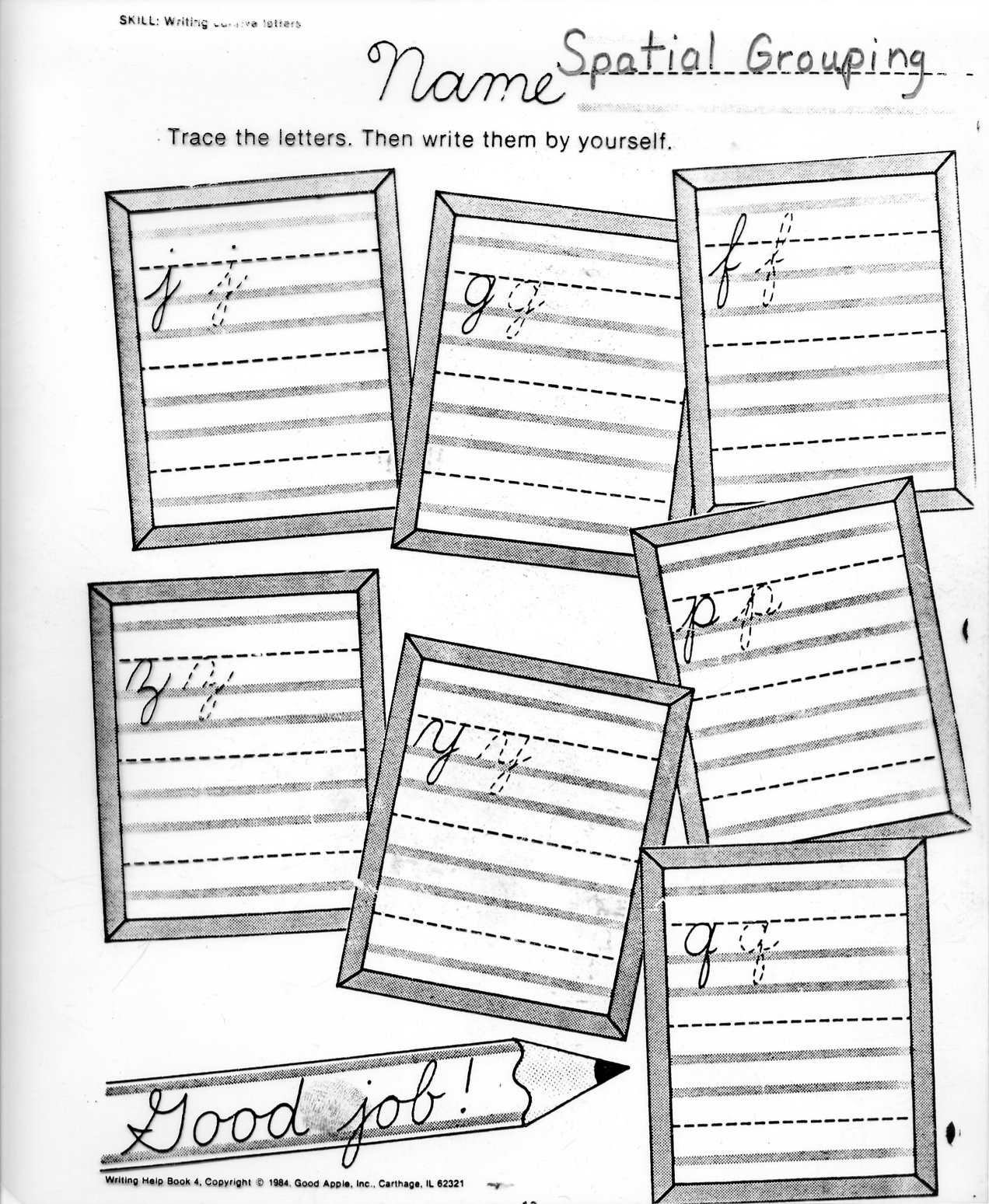
Temporal Grouping-presenting materials with a pause or time lapse between items.
Perceptual Grouping-placing certain items in a shape or configuration. In the following example, the learner writes the foods rich in Vitamin B in shapes that represent various groupings of food.
In the following example, the letter "c" is written as scales on a fish. Therefore "c" is also presented in a shape or configuration. In this example, a mediational strategy is also being used.
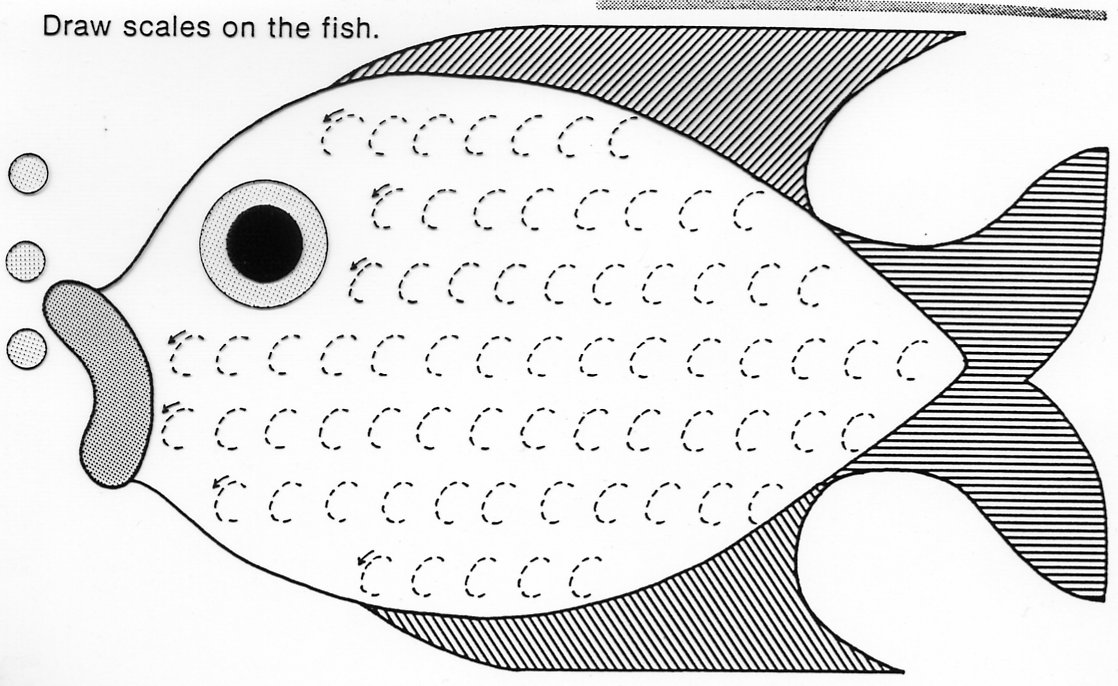
Categorical Grouping-grouping by content or commonality of items (items of
same color, items of same function, similar concepts). The most common type
of grouping is physical similarity and so this may be the first choice. But,
as the learner continues to develop, more advanced grouping strategies should
be used.
MEDIATION
A mediator is something that connects. In learning, a mediator is something
that connects a stimulus with a response. Mediators may be verbal or visual.
A verbal mediator for remembering the ABC's might be learning to sing them.
A verbal mediator for remembering how many days are in each month would be
reciting the rhyme "thirty days has September, April, June and November.......".
A visual mediator for remembering the number of days in each month might
be using your knuckles to recite the months with the knuckles representing
the
months with 31 days and the space between the knuckles representing the months
with fewer days. Another visual mediator, typical in most classrooms, is
the alphabet border that teachers hang around the room that includes a picture
with each letter to represent the sound of that letter.
Implications for Teaching
1. present materials that have relevance and are familiar to the learner
2. present information to learners grouped in meaningful parts
3. instruct learners in mediational strategies
MEMORY
Memory is the ability to retrieve information that has been stored. Memory,
as part of the learning process, has been very well researched and learners
with cognitive disabilities have found to perform less well on memory tasks
than their same age peers. Possible reasons for memory difficulties include:
1) lack of selective attention, 2) inefficient or nonexistent rehearsal strategies,
3) difficulties in developing learning sets, 4) difficulties in generalizing
learned skills to different stimuli (places, people, materials).
Short Term Memory-data stored from a few seconds to a few hours
Long Term Memory-information recalled after a period of days or months or even longer
Most researchers have supported that once information is learned, information
is retained by individuals with cognitive disabilities similarly to
their peers. These learners however, have greater difficulty with short
term
memory. Researchers
have found that it takes learners with cognitive disabilities more
time to reach levels of automaticity and fluency and they are less able
to
handle large
chunks of information at one time.
Strategies:
* Verbal rehearsal-self instruction. labeling aspects of a task and expressing these labels while completing a task (have you ever caught yourself doing this?)
* Image rehearsal-teaching the individual to associate parts of a task with pictures or events to later recall them
Executive Control or Metacognition-the process one goes through to determine a strategy, analyze a problem, anticipate outcomes, and monitor outcomes. Individuals with cognitive disabilities do not spontaneously employ executive control processes but they can be taught to use them effectively.
Techniques:
* organize material into meaningful segments
* reinforce remembering
* modeling appropriate strategies
* use spaced and repeated practice
* remind the learner to use rehearsal strategiesOBSERVATIONAL LEARNING
Observational learning refers to learning from demonstrations by
others. Modeling, imitation, and learning through observation
are associated
with observational
learning. Observational learning is important to acquiring
social skills, understanding gender roles, learning language, etc. Observational
learning
is important to
the development of new behaviors as well as the modification
of existing ones. Because learners with cognitive disabilities tend to
be
outerdirected,
in that
look to others for cues or guidance, observational learning
provides an important tool for instruction. Implications for Teaching:
1. be aware that any behavior may serve as a model
2. cues prompts or cues to direct student behavior
3. call attention to students using desirable behavior
4. ignore undesirable behavior so that others do not try to
get attention by copying the behavior
5. rewarding imitation of appropriate behavior
SPEECH AND LANGUAGE CHARACTERISTICS
Learners with cognitive disabilities are more apt to have speech
and language problems because cognitive ability and language
development are closely
related. Articulation problems are common with substitution,
omission, addition, or
distortion of sounds being typical problems. Delayed language
and limited
vocabulary are common problems. Motor dysfunction, typical
of individuals with cerebral
palsy, may increase communication difficulties.